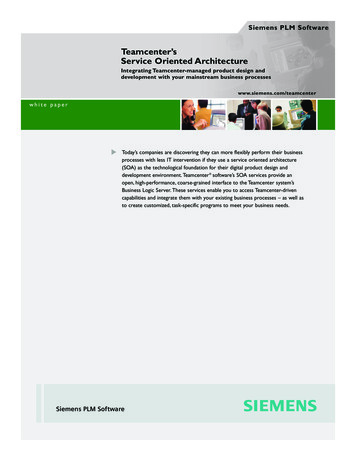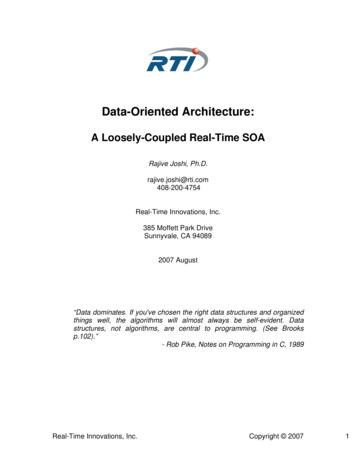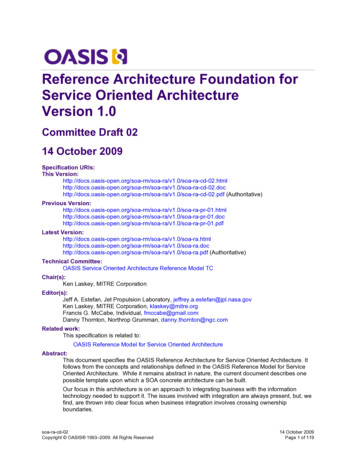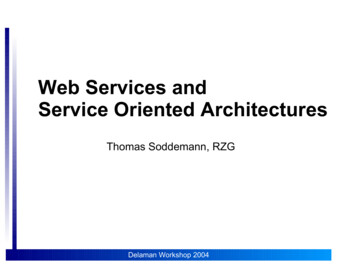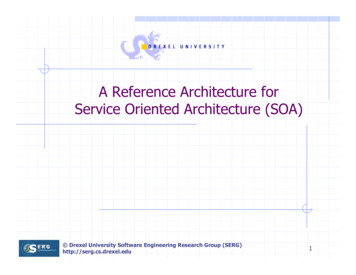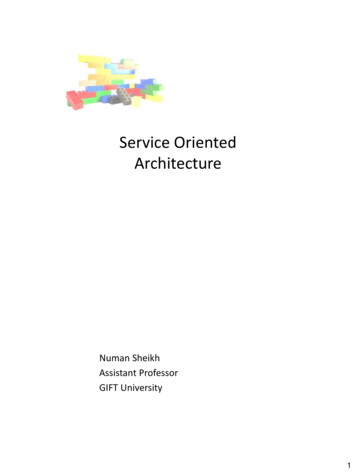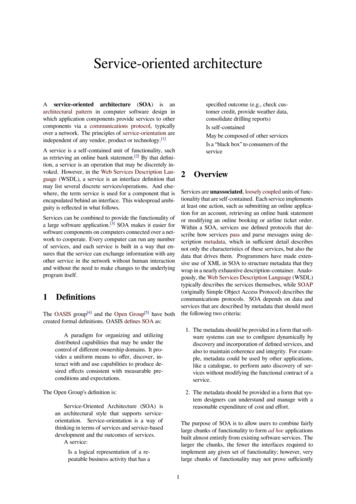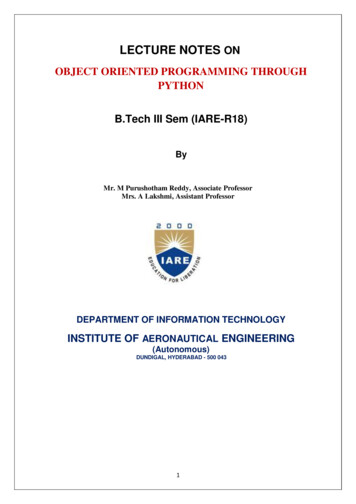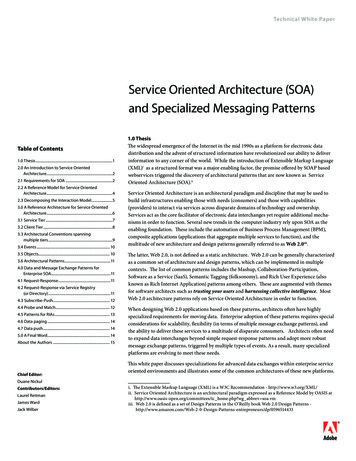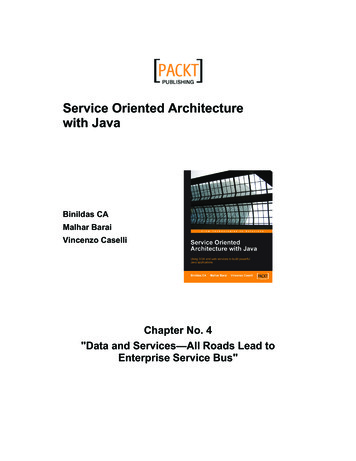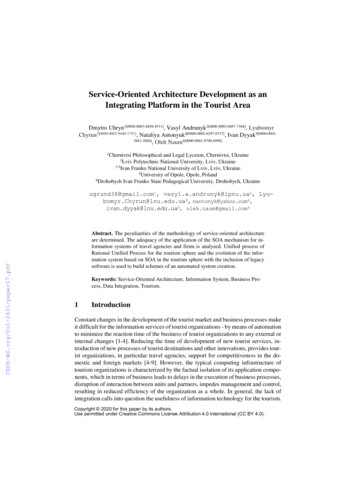
Transcription
Service-Oriented Architecture Development as anIntegrating Platform in the Tourist AreaDmytro Uhryn1[0000-0003-4858-4511], Vasyl Andrunyk2[0000-0003-0697-7384], LyubomyrChyrun3[0000-0002-9448-1751], Nataliya Antonyuk4[0000-0002-6297-0737], Ivan Dyyak5[0000-00015841-2604], Oleh Naum6[0000-0001-8700-6998]1Chernivtsi Philosophical and Legal Lyceum, Chernivtsi, Ukraine2Lviv Polytechnic National University, Lviv, Ukraine3-5Ivan Franko National University of Lviv, Lviv, Ukraine4University of Opole, Opole, Poland6Drohobych Ivan Franko State Pedagogical University, Drohobych, Ukraineugrund38@gmail.com1, vasyl.a.andrunyk@lpnu.ua2, Lyubomyr.Chyrun@lnu.edu.ua3, nantonyk@yahoo.com4,ivan.dyyak@lnu.edu.ua5, oleh.naum@gmail.com6Abstract. The peculiarities of the methodology of service-oriented architectureare determined. The adequacy of the application of the SOA mechanism for information systems of travel agencies and firms is analyzed. Unified process ofRational Unified Process for the tourism sphere and the evolution of the information system based on SOA in the tourism sphere with the inclusion of legacysoftware is used to build schemes of an automated system creation.Keywords: Service-Oriented Architecture, Information System, Business Process, Data Integration, Tourism.1IntroductionConstant changes in the development of the tourist market and business processes makeit difficult for the information services of tourist organizations - by means of automationto minimize the reaction time of the business of tourist organizations to any external orinternal changes [1-4]. Reducing the time of development of new tourist services, introduction of new processes of tourist destinations and other innovations, provides tourist organizations, in particular travel agencies, support for competitiveness in the domestic and foreign markets [4-9]. However, the typical computing infrastructure oftourism organizations is characterized by the factual isolation of its application components, which in terms of business leads to delays in the execution of business processes,disruption of interaction between units and partners, impedes management and control,resulting in reduced efficiency of the organization as a whole. In general, the lack ofintegration calls into question the usefulness of information technology for the tourism.Copyright 2020 for this paper by its authors.Use permitted under Creative Commons License Attribution 4.0 International (CC BY 4.0).
In most cases, these problems arise from the lack of architectural standards in information technology [10-15]. Moreover, not only standards but also a set of componentsthat are standardized are needed to overcome them. Just as necessary is the businessprocess for execution environment through which the components will linked [16-21].2General Problem FormulationUntil the end of the last century, the approach is based on the management and analysisof content flows dominated the construction of information systems. However, overtime, a process-oriented approach has emerged as more versatile and informative, inwhich the choice and modification of the information system structure, the compositionof its components, and the main characteristics are made dependent on the process,depending on its construction and end-user characteristics. Such a change in the position of developers has caused a powerful trend in information systems in the theory,methods and technologies of systems development - modeling and management ofbusiness processes, based on which all known ERP-systems are created. Nowadays, theanalysis application center is moving even more critical - towards manipulating theworks, building the tools for generating workflows and managing them. Business process management and workflow management are not the same thing. The electronicbusiness process determines what needs is done, including by establishing the relationship between output data and input data. A business process may include non-automated (or non-automated) components that are manually mastered, and it can use anykind of resources. The workflow describes how a particular result can achieved [2228]. However, the relationship between the business process and the workflow is quitesimple [1, 3, 29-36] and is illustrated by the scheme shown in Fig. 1 [1].Fig. 1. Relationship between business processes and workflows [1].As in the previous case, the change in the position of developers is explained by changesin the concept of building information systems. The transition nowadays to serviceoriented architecture (SOA) means, first, the need to distinguish functional services –elements of SOA, from which business processes, are synthesized and modernized.
3Analysis of Recent Research and PublicationsOASIS (Organization for the Advancement of Structured Information Standards),which focuses on the standardization of SOA components, defines service-oriented architecture as the paradigm of distributed organizational and utilitarian capabilities thatoperate under the ownership of domains belonging to different owners. [1, 5, 37-43].According to IBM definition [1, 6], SOA is an architectural style for creating an enterprise information architecture, based on a service orientation to achieve a closer relationship between business and supporting business systems. SOA introduces serviceorientation as an approach to business integration based on related services. Coupledwith the ability to make rapid changes to processes, the presence of such mechanismsis considered the basis for the effectiveness of information systems based on SOA.Business tools are used to solve the problems, which in the general case will provide[1, 44-52]: Building new business functions;Establishing links between business functions from existing applications;Generating workflows to execute business processes.In the most general form, SOA involves the presence of three main participants: theservice provider - travel agent, the consumer service - tourist, the register of services(Fig. 2) [53-60].Fig. 2. General scheme of SOA in tourism
Participant interaction looks simple enough: the service provider registers its servicesin the registry, and the consumer requests the registry. The absence of any of theseelements is unacceptable, and the addition of other components is not only possible butalso necessary in practice. Such elements may include various middleware, monitoringthe order and context of interaction, monitoring and managing services, and managingmetadata and other supporting processes. SOA is an application architecture in whichcomponents or services, with agreed common interfaces, use a single rule (contract) todetermine how to call services and how they will interact with each other. In this system, the concepts of "client" and "server" are situational absolutely. In one case, theapplication can act as a client and invoke an external service, and sometime after that,it can become a service provider when accessing another application for performingany tasks. If designed properly, SOA is capable of building and supporting customerto-customer integration. When using SOA, travel organizations can generate flexiblyand dynamically new services, combining the logic of existing applications and presenting them through reuse of services.For information systems of travel agencies and firms, we highlight the goals of SOA: Reducing the cost of developing applications by streamlining the process of developing tourism services;Extension of code reuse;Independence from the platforms, tools, programming languages used;Increasing the scalability of the created systems in connection with the development of tourist service;Improving the manageability of the created information systems.SOA principles: Architecture, as such, is not tied to any specific technology;Independence of organization of the system from the used computing platform;Independence of the organization of the system from the used programming languages;Use of services, independent of specific applications, with uniform interfacesfor access to them.Service-oriented Architecture is based on the following basic principles that help address the most pressing issues of application integration.Weak connection. In terms of implementation, services in SOA are independent ofeach other: they perform certain actions from requests received from other services andreturn results. All the details of this execution are completely hidden: in the concept ofSOA services are "black boxes". Therefore, changes in the implementation of the service will not affect the application component that the service uses, and vice versa.Weak connectivity provides a simple and quick adaptation of the system to changesin the structure and principles of service delivery."Coarse-grained" structure of services. Services in SOA are high-level businesslogic modules, whereby the interaction between them is reduced to a limited number ofmessages in the content of business logic instead of many low-level calls that take into
account the details of the implementation of services. This approach reduces networkload and contributes to higher system performance. Also important is that in terms ofarchitecture, service, regardless of internal structure and language of implementation,looks like a whole.Contracts. The concept of contract in SOA is interpreted somewhat more broadlythan usual. The contract defines the conditions for the provision and use of services,including functional, technical (not only the protocol, but also, for example, the methodof authorization) and other (cost of the permit, guarantees, insurance of the tourist) parameters and forms based on the agreement between the consumer and the service provider at all stages of it the interaction process. One of the common definitions of aprovider and a consumer of services is based on who of them gives the contract (travelprovider) and who receives (tourist). The contract allows dividing components into twoparts - public, more stable, and hidden, one that is constantly changing. Because theway organization of components in SOA corresponds to the way business or computingis organized, the contract outlines not so much the software component as the businessor computing functionality, dividing the service into a business (computing) interfaceand a business (computing) process.Contracts not only weaken the links between elements of architecture, but, equallyimportant, make them explicit, object-oriented objects of management.Composition. The main advantage of the composition is the ability to reuse previously implemented functionality. However, the composition also contributes to adaptability, because it allows you to make many changes faster by changing the connectionsbetween services. Such changes are much easier than changing the whole service.Dynamic linking. Relying on the stability of the contract, the consumer can find thenecessary copies of services without interruption. This means that the system is resistant to changes not only in addressing available services (moving to another server),but also in their composition, which can change during operation. For example, newpartners may emerge - travel agents, or the responsibility for providing the necessarybusiness function may transferred to another provider, including an external one, butthis will not affect the work of the consumer. Dynamic linking is supported by a registrythat performs SOA accounting functions. Typically, it contains links to contracts, specific instances of services, information about their service providers, and sometimestheir customers. All of this, in addition to other equally important functions, is also aconfiguration of SOA, which determines the parameters of the execution time of theservices used for consumers of services (due to the composition of those who are oftentheir providers). SOA is a set of interoperable design principles, and dynamic linkingis often referred to as the most specific. Dynamic linking benefits are especially neededwhen operating large or decentralized information services or when interacting with anumber of parties working on an identical or very similar contract. These can be affiliates of a travel company (for example, retail outlets - restaurants, hotels, sanatoriums,and so on), but more often they are partners - travel providers, travel agents, and more.Scalability of interfaces. It is a good practice to leave the possibility of adding previously unforeseen data elements in the message transmission. Thus, a contract in advance allows for some flexibility if it is possible and necessary in a particular situation.
Reconstruction. Scalability is good but not good enough. The interface should always reflect the functionality as fully as possible, and scalability does not solve majorchange management issues. Therefore, eventually, the interface has to change, adapt tochanging business requirements. What procedures are being launched, each company(in the person of the responsible information manager) determines for its organization,depending on many factors, not the last of which - a balance of logic and intuition inthe style of decision making. More stable organizations are characterized by greaterregulation of the change process, and less flexible ones.4Formation of GoalsThe aim of the study is to increase the flexibility of information systems in the tourismindustry with data, reduce the cost of application development, increase the speed ofresponse to the constant changes in the requirements of the tourism business, as well asprovide the necessary level of integration between information systems with the helpof SOA - service-oriented architecture.5The System Architecture DevelopmentA number of standards are used to successfully integrate systems based on Web services, the main ones being: BPEL is business process implementation language;WSDL is service description language;SOAP is messaging protocol;UDDI is universal directory format for searching and integrating Web services.The composition of Web services based on elementary works is performed using Business Process Execution Language (BPEL) [1]. It emerged because of the merger of theWeb Services Flow Language (WSFL) by IBM and the XLANG language by Microsoft. The language is based on XML notation [1].The use of this language allows the formation and execution of workflows as a seriesof logical actions, including: Accepting a request to include work in the process;Rejection of request;Check the description, and if the parameters match, prepare a positive responseto the request.BPEL generates a workflow consisting of sequences of logical actions or active operations, each of which corresponds to its own square in the workflow diagram or functioncode [1]. There are two possible uses of BPEL:
1.Performed BPEL is a process that is also considered a service and can be anorchestration node [1]. Software products that implement executable BPEL processes are BPEL engines. Here one running process can include another, whichgives the effect of including one orchestration (sequence of services) in another,as shown in Fig. 4.Fig. 3. Standardization of types of services2.The abstract process is almost identical to the executable process except for thedata filling [1]. In this capacity, it represents the logic of the business processand is used for the following purpose:o Defines the behavior of the elements of the organizational structurethat supports the process;o A guide for programmers and developers who automate the process;o Considered an entry for commercial software that forms the structureof the system.Fig. 4. Scheme of connected orchestration [1].WSDL (Web Services Description Language) is an XML-based Web server-description language. Provides the right choice of services for transmission from provider to
consumer. WSDL information is used by service developers to integrate services intothe system.SOAP (Simple Object Access Protocol) is also an XML messaging protocol designed to transmit data from Web services. Auto-generated SOAP files include WSDLservice description data.UDDI is a set of rules for registering and retrieving information about available services. When developing programs, programmers can search the UDDI registry for theservices they need to include in the programs. This registry may be necessary in theprocess of executing an application that needs data-providing services, such as the costof travel services or permits.Consider at the business processes that IBM has put in place that have introduced aunified process description - Rational Unified Process (RUP). Fig. 5 shown an exampleof creating an automated system using RUP and IBM software.Fig. 5. Creating an automated system using a Rational Unified Process for the tourism industry
Fig.5 demonstrates interaction head of travel agency, project manager, risk assessment,project cost and profitability, creation of an imitation model of business process "existing system", creation of an imitation model of business process "future system", processchoreography, configuration of non-automated tasks, collection of applications, forming and managing system requirements, testing, requirements tracking and implementation of precedents, designing, development of portlets, architect, researcher, Java developer, portal developer, monitoring, database administrator, business operations analyst. Below describe is a systematic description of the unified process of creating aninformation system.Step 1. The Rational Portfolio Manager application helps you achieve top-level modeling alignment on metrics such as profitability (ROI), cost, and other business conditions.Step 2. A business analyst develops a business process model using the WebSphereBusiness Modeler application.Step 3. Rational Software Architect represents the business process in UML standardnotation.Step 4. Rational Software Architect converts the model in UML notation to Javacode.Step 5. IBM Rational Application Developer automates the process of creating newWeb services based on existing resources, such as JavaBeans or EJB components, byautomatically generating WSDL files describing Web services, SOAP descriptors, anda client to test Web services. For example, in a portlet form. Portlet is a standard portalcomponent, which is designated for a user interface being build (Wikipedia). The portlet selects the snippets that are embedded in the portal page. You can think of a portalpage as a collection of non-overlapping portlet windows, each displaying a portlet. Aportlet is as a web server application hosted on a portal. Examples of portlets: e-mail,flight announcements, latest travel news and promotions. With existing portlet standards, developers can create portlets that are built into any standards-compliant portal.Step 6. WebSphere Integration Developer implements a business process in BPELformat. A developer who integrates web services into a business process can extract aready-made service from UDDI and incorporate it into the business process, or incorporate functions performed by people. The result is expanded as an application WebSphere Process Server.When implementing projects that use process management, the project manager andteam members use Rational Clearquest to support the development. This product automates task assignment and tracks progress, and is used to test and detect defects in theprojected workflow. It is also used when editing, certifying, and verifying services.IBM Rational Clearcase integrated with Eclipse is used for configuration management tasks.Often, the argument against the transition to SOA is the claim that it is associatedwith a complete breakdown of the entire existing system, and therefore requires a muchcost. In fact, the transition to SOA does not require a complete change to the existinginformation system. It uses technologies that ensure compliance with previously introduced standards, as well as heredity with respect to previously installed able-bodiedsoftware products and technical equipment. Fig 5 shows the generalized evolutionary
structure of SOA in tourism. Fig. 6 illustrates a typical situation where an SOA-basedinformation system is built on existing software. As an example, such popular applications as SAP, SAS, office packages, as well as client software and applications inheritedfrom previous stages of system development are shown.Fig. 6. An example of an evolutionary service-oriented architecture in tourismMany analysts trace the history of SOA since the end of the last century, referring tothe development of a functional approach, and later the concept of COBRA and toolsJava. However, it did not become widespread because the architecture used at that timelacked a service level. Plural applications had different GUI, incompatible businessprocess logic, different storage systems of data. All of this made the system difficult.The implementation of business processes is related directly the technological level anddepended on the content speed.Fig 6 demonstrates interaction of processes as monitoring of business processes,business process (x6), level of business processes, organizational services, personnelservices, financial services, scheduled services, medical services, excursion services,leisure services, platform of services, level of services, software, SAP, applicationlevel, technological levelThe transition to a modern SOA and the inclusion of an additional service layer in itforms a line of autonomous services, each of which is tied to the respective business
domain and platform of Web services, which allows carrying out their use largely, regardless of the downstream applications and technological level platform.The introduction of the service level also creates convenient conditions for the construction of higher-level business processes and their functioning, namely [1]: The business services line reproduces a rough set of features that are ready tobe incorporated into the business process;;The description (contract) of each service in the service line uniquely defines it,forming an interface. The presence of the latter allows you to create businessprocesses independently and without involving knowledge of the technologyplatform;The registry and search tool maintains the dynamism and ability to change business processes by quickly accessing services when needed.;The data model implemented at the service level relies on the structure of thebusiness domain and is independent of the data models of individual applications. Because XML is used as a canonical data exchange format, the inclusionof the service in the business process is also carried out regardless of the internaldata structure in the applications;The service protection model operating within this layer provides universal control of the role distribution and connection of the service, authorizing the use ofthe service by some process. It also avoids the difficulty of interacting directlywith application security tools, with their differences in organization principles,interfaces.The service level management model generates statistics on the use of services, whichis part of the monitoring of the top level business process (business processes).The lackof this level in previous generations of information systems created many problems thatcontributed to the rapid degradation of business processes, and this factor inhibited thespread of SOA.Here is an example that recreates the possibility of transition to SOA in the tourismsphere through the evolution and improvement of the system, which does not requireone-time high costs and complete destruction of the usual process of the system functioning. In this example, the transition to SOA is carried out in stages (Fig.7).Fig. 7 shows the developing system, we give an example of two subsystems - personnel, finance, and analyze their databases. In the first stage of evolution, new servicesare being developed that are included in these subsystems. The following shows services built on inherited applications. These services retain the design features of the oldsystem. To use them in a future system, they are combined into a common shell, whichis presented as an interface designed already under the new logic of process implementation.
Fig. 7. Evolution of SOA-based information system in tourism with the inclusion of inheritedsoftware.Fig.7 is tourist diagram of data structure, component interfaces, descriptions of inherited products, process reengineering, object models, data models, service models,model processes, Databases, services base, process bases, interface of interaction of models oftourist sphere,User database, security within the service level, service registry and search, platform of services, level of service of information services, service level management, database of roles and powers, database of frames, data of frames, data offinance, inherited data, business rules, business requirements, business order,the interface of the inherited software products, composite services, businessprocesses, firewallWith the tools included in the service level (registry, service level management services, security, and business process building), a business process is built that integratesboth new services and outdated software. The development of such a scheme can serveas the basis for organizing and planning the process of transition to SOA in the tourismsphere through the gradual development of the information system.
6ConclusionsThe article describes the methodology of service-oriented architecture to create information architecture of the tourism industry, which is based on a service orientation tobuild a closer relationship between business and supporting business systems. The application of SOA service orientation is proposed as an approach to the tourism businessintegration on the basis of interconnected services through the evolution and improvement of the system, which does not require one-time large expenses and complete destruction of the usual process of system functioning. The application of SOA serviceorientation is proposed as the tourism business integration on the basis of interconnected services through the evolution and improvement of the system, which does notrequire one-time large expenses and complete destruction of the usual process of system functioning.References1. Shendryk, V., Boiko, A.: Stages of Information System Development in the Process Approach", Procedia Computer Science (2015)2. Su, J., Sachenko, A., Lytvyn, V., Vysotska, V., Dosyn, D.: Model of Touristic InformationResources Integration According to User Needs. In: Proceedings of the International Conference on Computer Sciences and Information Technologies, CSIT, 113-116. (2018)3. Mathias Weske. Business Process Management. Springer-Verlag, Berlin-Heidelberg,(2008).4. Varetskyy, Y., Rusyn, B., Molga, A., Ignatovych, A.: A new method of fingerprint key protection of grid credential. In: Advances in Intelligent and Soft Computing, 84, 99-103.(2010)5. Bobby Woolf Exploring IBM SOA. Technology&Practice. Maximum press (2009).6. IBM Redbook. Patterns: Implementing an SOA Using an Enterprise Service Bus,http://www.ibm.com/Index.cfm?ArticleID 22084, last accessed 2020/05/01.7. Kravets, P.: Game method for coalitions formation in multi-agent systems. In: InternationalScientific and Technical Conference on Computer Sciences and Information Technologies,CSIT, 1-4. (2018)8. IBM Redbook Patterns: Service-Oriented Architecture and Web 46303.html, last accessed 2020/05/01.9. Berko, A.Y., Aliekseyeva, K.A.: Quality evaluation of information resources in web-projects. In: Actual Problems of Economics 136(10), 226-234. (2012)10. SOA Development Using the IBM Rational Software Development Platform,http://www07.ibm.com/sg/soa/downloads/SOA Development using Rational Software, ,last accessed 2020/05/01.11. Lytvyn, V., Vysotska, V., Burov, Y., Demchuk, A.: Architectural ontology designed forintellectual analysis of e-tourism resources. In: Proceedings of the International Conferenceon Computer Sciences and Information Technologies, CSIT, 335-338. (2018)12. Antonyuk, N., Vysotsky, A., Vysotska, V., Lytvyn, V., Burov, Y., Demchuk, A.,Lyudkevych, I., Chyrun, L., Chyrun, S., Bobyk, І.: Consolidated Information Web Resourcefor Online Tourism Based on Data Integration and Geolocation. In: Proceedings of the International Conference on Computer Sciences and Information Technologies, CSIT, 15-20.(2019)
13. Vysotsky, A., Lytvyn, V., Vysotska, V., Dosyn, D., Lyudkevych, I., Antonyuk, N., Naum,O., Vysotskyi, A., Chyrun, L., Slyusarchuk, O.: Online Tourism System for Proposals Formation to User Based on Data Integration from Various Sources. In: Proceedings of theInternational Conference on Computer Sciences and Information Technologies, CSIT, 9297. (2019)14. Shakhovska, N., Shakhovska, K., Fedushko, S.: Some Aspects of the Method for TouristRoute Creation. In: Advances in Artificial Systems for Medicine and Education II, 902, 527537. (2019)15. Antonyuk, N., Medykovskyy, M., Chyrun, L., Dverii, M., Oborska, O., Krylyshyn, M.,Vysotsky, A., Tsiura, N., Naum, O.: Online Tourism System Development for Searchingand Planning Trips with User’s Requirements. In: Advances in Intelligent Systems andComputing IV, Springer Nature Switzerland AG 2020, 1080, 831-863. (2020)16. Lozynska, O., Savchuk, V., Pasichnyk, V.: Individual Sign Translator Component of TouristInformation System. In: Advances in Intelligent Systems and Computing IV, Springer Nature Switzerland AG 2020, Springer, Cham, 1080, 593-601. (2020)17. Savchuk, V., Lozynska, O., Pasichnyk, V.: Architecture of the Subsystem of the TouristProfile Formation. In: Advances in Intelligent Systems and Computing, 871, 561-570.(2019)18. Zhezhnych, P., Markiv, O.: R
Service-oriented Architecture is based on the following basic principles that help ad-dress the most pressing issues of application integration. Weak connection. In terms of implementation, services in SOA are independent of each other: they perform certain actions from

